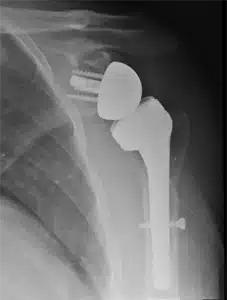Fracture of the Proximal Humerus (Shoulder Injury)
Basic Anatomy
The shoulder comprises three bones: the clavicle (collarbone), the scapula (shoulder blade), and the humerus (upper arm bone). The upper portion of the humerus is referred to as its proximal part. Numerous muscles envelop the shoulder, such as the rotator cuff muscles, deltoid muscle, pectorals muscle, and several robust muscles from the back. Arteries and nerves providing the arm emerge from beneath the clavicle bone and extend down the arm anterior to the shoulder.



Mechanism and Epidemiology
The proximal humerus is frequently fractured among older individuals, typically resulting from routine falls or trips, given the bone’s increased susceptibility to weakness with age, often resulting in multiple fragmented breaks.
Conversely, for children and younger adults, a more forceful impact, such as those experienced in motor vehicle accidents, falls from significant heights, or during sports activities, is necessary to fracture the proximal humerus. This area’s numerous muscle attachments can lead to a variety of fracture patterns, underscoring the importance of consulting with your physician regarding the precise nature of your fracture.

Initial Treatment
Proximal humerus fractures often cause severe pain, particularly during arm movement, even simple actions like breathing can be uncomfortable. Swelling and bruising may be prominent in the armpit, chest, and along the arm, possibly extending to the hand or fingers. Upon initial medical evaluation, shoulder and arm examination will be conducted, typically followed by X-rays. Unless there are accompanying injuries, hospital admission is usually unnecessary, and patients are typically discharged with a sling for support. Lying flat can exacerbate discomfort, so sleeping in a recliner chair might be more tolerable. Maintaining mobility in the elbow, wrist, and hand is crucial to prevent stiffness. Follow-up appointments with an orthopedist or primary care physician are recommended for ongoing care and monitoring.
General Treatment
The majority of proximal humerus fractures can be managed without surgery, with the bone typically healing within 3 to 4 months. During this period, engaging in exercises to restore range of motion, strength, and normal activities is essential. Even if surgical intervention is pursued, achieving full function may require up to 18 months of recovery. However, if surgery is not deemed necessary, there may be a period of restricted movement and lifting as advised by your doctor based on the specifics of your fracture.
Certain proximal humerus fractures may benefit from surgical intervention, which can be discussed with an orthopedic surgeon who can weigh the advantages and disadvantages compared to non-surgical treatment for your particular injury. Surgery is typically indicated for open fractures (where the bone penetrates the skin) or if the bone is at risk of breaking through the skin, and in cases of shoulder dislocation. Otherwise, surgical intervention is not usually necessary unless deemed appropriate by your medical team. In surgical cases, the surgeon will make an incision over the shoulder, realign the bones, and utilize metal plates and screws for fixation. In instances where the shoulder is severely fragmented and unlikely to heal with conventional repair, shoulder replacement may be recommended as an alternative by the surgeon.


Post-operative Care
During the healing process of your proximal humerus fracture, it’s probable that you’ll experience limited shoulder mobility and be unable to lift objects weighing over 1 or 2 pounds. This limitation may stem from pain and/or recommendations provided by your surgeon. Many surgeons advise against specific movements until the bone shows signs of healing. Additionally, physical therapy may be prescribed post-surgery to aid in motion, lifting, and pain management. The use of a sling for comfort is common, but it’s essential to periodically remove it throughout the day and engage in elbow, wrist, and hand movements to prevent stiffness. As the bone heals, your shoulder mobility and lifting capacity will gradually improve. Adhering to your surgeon’s instructions is vital for optimal recovery outcomes.
Long Term
Following a fracture of the proximal humerus, individuals may encounter long-term challenges such as stiffness, tenderness, and difficulty regaining full pre-injury strength. Achieving a return to previous activities might necessitate several months of physical therapy. The affected shoulder may perpetually exhibit altered sensation and mobility compared to the uninjured side.
While most proximal humerus fractures do heal, some may fail to do so or may heal in a manner that causes discomfort or restricts movement. Arthritis may develop in some cases, leading to escalating pain and stiffness, irrespective of whether surgery was performed. In older patients experiencing severe pain, shoulder replacement surgery might be recommended. Younger patients may receive advice from their surgeon regarding the removal of hardware or other surgical interventions to address ongoing issues.


